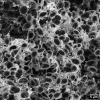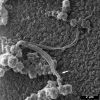Bio-imaging with the helium-ion microscope: A review
- PMID: 33489663
- PMCID: PMC7801799
- DOI: 10.3762/bjnano.12.1
Bio-imaging with the helium-ion microscope: A review
Abstract
Scanning helium-ion microscopy (HIM) is an imaging technique with sub-nanometre resolution and is a powerful tool to resolve some of the tiniest structures in biology. In many aspects, the HIM resembles a field-emission scanning electron microscope (FE-SEM), but the use of helium ions rather than electrons provides several advantages, including higher surface sensitivity, larger depth of field, and a straightforward charge-compensating electron flood gun, which enables imaging of non-conductive samples, rendering HIM a promising high-resolution imaging technique for biological samples. Starting with studies focused on medical research, the last decade has seen some particularly spectacular high-resolution images in studies focused on plants, microbiology, virology, and geomicrobiology. However, HIM is not just an imaging technique. The ability to use the instrument for milling biological objects as small as viruses offers unique opportunities which are not possible with more conventional focused ion beams, such as gallium. Several pioneering technical developments, such as methods to couple secondary ion mass spectrometry (SIMS) or ionoluminescence with the HIM, also offer the possibility for new and exciting research on biological materials. In this review, we present a comprehensive overview of almost all currently published literature which has demonstrated the application of HIM for imaging of biological specimens. We also discuss some technical features of this unique type of instrument and highlight some of the new advances which will likely become more widely used in the years to come.
Keywords: HIM; HIM-SIMS; bio-imaging; flood gun; helium-ion microscopy; high resolution; ionofluorescense.
Copyright © 2021, Schmidt et al.; licensee Beilstein-Institut.
Figures
















References
-
- Ward B W, Notte J A, Economou N P. J Vac Sci Technol, B: Microelectron Nanometer Struct–Process, Meas, Phenom. 2006;24:2871–2874. doi: 10.1116/1.2357967. - DOI
-
- Ward B, Notte J A, Economou N P. Photonics Spectra. 2007;41:68–70.
-
- Notte J, Ward B, Economou N, Hill R, Percival R, Farkas L, McVey S. AIP Conf Proc. 2007;931:489–496. doi: 10.1063/1.2799423. - DOI
-
- Scipioni L, Stern L A, Notte J, Sijbrandij S, Griffin B. Adv Mater Processes. 2008;166(6):27–30. Product code: ZAMP16606P27.
-
-
Carl Zeiss Microscopy, White paper: Zeiss Orion Plus (2008), (not available online anymore).
-
Publication types
LinkOut - more resources
Full Text Sources
Other Literature Sources
